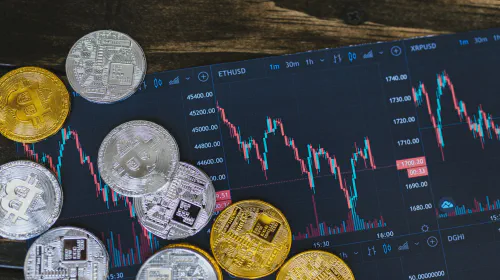Algorand: Solving the Blockchain Trilemma with Security, Decentralization, and Scalability
Salomon Kisters
Nov 24, 2022This post may contain affiliate links. If you use these links to buy something we may earn a commission. Thanks!
If you’re an investor in blockchain technology, or if you’re just starting to learn about it, you’ve probably heard of the “blockchain trilemma.” This term describes the inherent trade-offs that come with blockchain technology.
Blockchains can have security, scalability, and decentralization, but never all three at the same time.
Until now!
A perfect blockchain technology would have airtight security, an extensive decentralized network, and an immense capacity to handle huge volumes of transactions. Algorand is a blockchain protocol that solves the blockchain trilemma, making it possible for blockchains to have all three properties simultaneously.
In this blog post, we’ll take a closer look at how Algorand achieves this feat and what implications it could have for the future of blockchain technology.
What is the Blockchain Trilemma?
The blockchain trilemma is a set of problems affecting the blockchain industry. It is a situation where there are three options, but at most only two of them are possible to achieve at the same time. In the case of the blockchain trilemma, the three options are security, scalability, and decentralization.
If the trilemma holds, there are no good situations with just two options being true. For example, if a blockchain is secure and scalable but not decentralized, then it is essentially the same as the current system which is exclusive and secretive. The only way to have all three options is to have a completely decentralized network that is secure and scalable. However, this has proven to be difficult to achieve in practice.
The blockchain trilemma is also sometimes referred to as the “scalability trilemma” or the “crypto trilemma”.
What is Algorand and How Does it Solve the Blockchain Trilemma?
Algorand is a blockchain protocol that solves the trilemma, making it possible for blockchains to have all three properties together. In this blog post, we’ll take a closer look at how Algorand achieves this act and what implications it could have for the future of blockchain technology.
For starters, Algorand is a permissionless, pure proof-of-stake blockchain protocol that enables fast, secure, and scalable transactions. The protocol is designed to be censorship-resistant and permissionless, meaning anyone can participate in the network without needing approval from a central authority.
Algorand uses a novel consensus algorithm called “Pure PoS” which allows all participating nodes to reach a consensus on the order of transactions without the need for a central authority. This makes Algorand much more scalable than other existing blockchain protocols.
The blockchain also uses a unique data structure called “the Byzantine Agreement”, which allows the network to achieve consensus even when some of its participants are malicious, given that enough honest users control more than two-thirds of the system’s stake.
In essence, Algorand uses a unique consensus algorithm that is designed to be secure, scalable, and decentralized. This makes it the first blockchain to successfully solve the trilemma. The Algorand consensus algorithm is based on Proof-of-Stake (PoS). PoS is a type of consensus algorithm where validators stake their tokens to have a chance of validating the next block.
The Algorand consensus algorithm is different from other PoS algorithms in that it uses a unique “verifiable random function” (VRF) which allows for true decentralization. The VRF is a function that takes a seed as input and brings out a random value as output. This random value is used to determine which validators will be chosen to validate the next block.
The VRF is verifiable in the sense that anyone can check that the output of the function is truly random. This is important because it means that there is no way for any single entity to control which validators are chosen.
The Algorand consensus algorithm also uses a “weighted vote” system which ensures that the validators with the most tokens at stake have the most influence over the network. This is important because it means that the network is not controlled by a small number of large stakeholders.
The Algorand consensus algorithm is the first and only consensus algorithm that is secure, scalable, and decentralized. This makes Algorand one of the few blockchains to successfully solve the blockchain trilemma.
Does Algorand’s Method for Resolving the Blockchain Dilemma Have Any Potential Drawbacks?
There are a few potential drawbacks to Algorand’s approach to solving the blockchain dilemma.
First, it is possible that Algorand’s consensus algorithm could be vulnerable to attacks. While the team has invested a lot of time and work to try to mitigate this risk, it is impossible to say for sure that the algorithm is completely secure.
Second, because Algorand does not use Proof-of-Work (like Bitcoin or Proof-of-Stake mechanism (like Ethereum), it is possible that the network could be susceptible to Sybil attacks. This type of attack occurs when someone creates multiple identities on a network to control a larger portion of the network.
Lastly, because Algorand is a permissionless network, anyone can join and start participating in the consensus algorithm. This could lead to a situation where the network is overloaded with users, which will make it slower and less efficient.
Overall, one could say that there are still some potential drawbacks to Algorand’s approach that blockchain developers must address. And, if the protocol is successful, it could have a major impact on the entire blockchain industry.
The Future of Algorand and How it Will Shape Blockchain Technology
The future of Algorand looks promising. In fact, Algorand has the potential to shape the future of blockchain technology. It is a very innovative platform that has the ability to scale.
Algorand can handle a large number of transactions per second. It is also very secure and has a very low chance of forks. At the same time, Algorand has a great team of developers who are constantly working on new features and improving the platform.
There are many different aspects to Algorand that make it so special. One thing that sets it apart from other platforms is its consensus algorithm. As already mentioned, Algorand uses a Proof-of-Stake algorithm which is very different from the Proof-of-Work algorithm that is used by most other cryptocurrencies.
The main advantage of using a Proof-of-Stake mechanism is that it is more energy efficient and it doesn’t require a lot of computing power. This means that Algorand can run on a much wider range of devices and it is more accessible to so many more people.
Another great thing about Algorand is its scalability. It can handle a large number of transactions per second, as opposed to older cryptocurrencies, for example, Bitcoin.
Because Algorand uses a directed acyclic graph, there is no longer the need for having blocks in the blockchain network. This makes Algorand very scalable and able to handle a large number of transactions.
The icing on top is that Algorand also has a great team of developers who are constantly working on new features and improving the platform. They have already released a number of very successful products such as Algo Wallet and Algorand Standard Assets. They are also working on a number of other projects that will be released in the future.
Important Use Cases for Algorand
There are many different use cases for Algorand, which we will now turn our attention to.
- One of the most important use cases for Algorand is definitely ICOs (Initial Coin Offerings). Algorand can be used to launch an ICO, mainly because Algorand is very scalable and can handle a large number of transactions. This means that an ICO on Algorand can reach a much wider audience. Algorand can also be used to launch an STO (Security Token Offering) because it is much more secure and has a very low chance of forks.
- Another important use case for Algorand is smart contracts. Algorand can be used to create smart contracts due to the high level of security and low likelihood of forks possible with the blockchain. As a result, smart contracts on Algorand will be extremely safe and unlikely to be prone to fraudulent activities.
- Algorand can also be used to set up a decentralized exchange. This is made possible because of Algorand’s high level of security and minimal likelihood of forks. It, thus, means that a decentralized exchange on Algorand will be extremely secure and resistant to fraud.
Conclusion
Algorand is the next generation of blockchain which aims to be secure, scalable, and decentralized all at the same time. We hope that today’s post has helped our readers to better understand how Algorand works and how it can play an important role in the future of blockchain technology.
While there are still some challenges that need to be addressed, we believe that Algorand has the potential to revolutionize the way that blockchains are built and used, and open a new page for decentralized applications.
We encourage you to continue learning about this protocol and to participate in the Algorand community if you’re interested in helping to shape the future of blockchain technology.
Stay informed with the latest insights in Crypto, Blockchain, and Cyber-Security! Subscribe to our newsletter now to receive exclusive updates, expert analyses, and current developments directly to your inbox. Don't miss the opportunity to expand your knowledge and stay up-to-date.
Love what you're reading? Subscribe for top stories in Crypto, Blockchain, and Cyber-Security. Stay informed with exclusive updates.
Please note that the Content may have been generated with the Help of AI. The editorial content of OriginStamp AG does not constitute a recommendation for investment or purchase advice. In principle, an investment can also lead to a total loss. Therefore, please seek advice before making an investment decision.

Solana vs. Algorand - A Comprehensive Comparison
Get a detailed comparison of Solana vs. Algorand including their consensus mechanisms, tokenomics, adoption, and more to decide which blockchain network is better suited for your needs.

Can Algorand Be Like Ethereum, and Does It Have a Future?
Today, we will be closely looking at how Agorand compares with Ethereum and whether this new, emerging cryptocurrency has a prosperous future or not.

Does Cardano Solve the Blockchain Trilemma?
Cardano is a blockchain platform aimed at solving the blockchain trilemma by delivering all three functionalities in a single platform.
Protect your documents
Your gateway to unforgeable data. Imprint the authenticity of your information with our blockchain timestamp